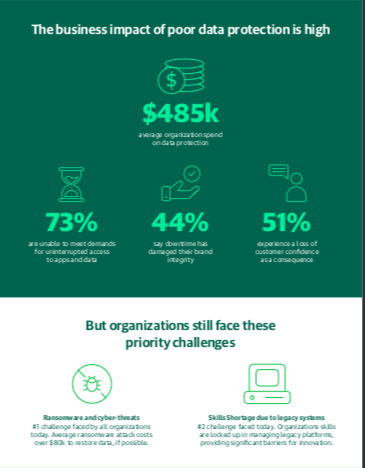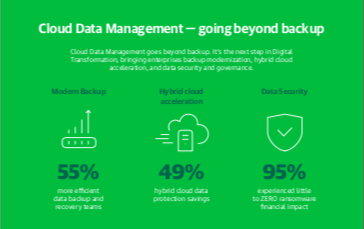Legacy Tech Top Barrier Deterring DX Agendas For CXOs: Veeam
Veeam 2020 Data Protection Trends Report indicates global businesses are embracing Digital Transformation, but struggle with antiquated solutions to protect and manage their data.


The latest Veeam 2020 Data Protection Trends Report by Veeam Software highlights that almost half of global firms are facing obstacles in their digital transformation journeys largely due to legacy technologies.
The Veeam 2020 Data Protection Trends Report surveyed more than 1,500 global enterprises to understand their approach toward data protection and management today, and how they expect to be prepared for the IT challenges they face, including reacting to demand changes and interruptions in service, as well as more aspirational goals of IT modernization and DX.
The report comes at a time when more than ever, digital transformation goals have gained prominence and technology leaders across verticals are looking at ways to fast-track their journey to the digital sphere. This is further reiterated in an IDC report where the research firm expects digital transformation (DX) spending to reach $7.4 trillion between 2020 and 2030, a CAGR of 17.5%.
While this maybe the case, however, according to Veeam, the road to achieving digital transformation is not without its challenges.
 As per the Veeam report, 44% have cited lack of IT skills or expertise as another barrier to success. Moreover, almost every company admitted to experiencing downtime, with 1 out of every 10 servers having unexpected outages each year — problems that last for hours and cost hundreds of thousands of dollars – and this points to an urgent need to modernise data protection and focus on business continuity to enable DX.
As per the Veeam report, 44% have cited lack of IT skills or expertise as another barrier to success. Moreover, almost every company admitted to experiencing downtime, with 1 out of every 10 servers having unexpected outages each year — problems that last for hours and cost hundreds of thousands of dollars – and this points to an urgent need to modernise data protection and focus on business continuity to enable DX.
Danny Allan, CTO and SVP of Product Strategy, Veeam, said, “Technology is constantly moving forward, continually changing, and transforming how we do business – especially in these current times as we’re all working in new ways. Due to DX, it’s important to always look at the ever-changing IT landscape to see where businesses stand on their solutions, challenges and goals.”
According to Allan, while it is great to see the global drive to embrace technology to deliver a richer user experience, the Achilles Heel still seems to be how to protect and manage data across the hybrid cloud.
“Data protection must move beyond outdated legacy solutions to a higher state of intelligence and be able to anticipate needs and meet evolving demands. Based on our data, unless business leaders recognise that – and act on it – real transformation just won’t happen,” he added.
The Criticality of Data Protection and Availability
Respondents stated that data delivered through IT has become the heart and soul of most organisations, so it should not be a surprise how important “data protection” has become within IT teams, including not just backing up and restoring data, but also extending business capabilities. However, many organisations (40%) still rely on legacy systems to protect their data without fully appreciating the negative impact this can have on their business. The vast majority (95%) of organisations suffer unexpected outages and on average, an outage lasts 117 minutes (almost two hours).
 Putting this into context, organisations consider 51% of their data as ‘High Priority’ versus ‘Normal’. An hour of downtime from a High Priority application is estimated to cost $67,651, while this number is $61,642 for a Normal application. With such a balance between High Priority and Normal in percentages and impact costs, it’s clear that “all data matters” and that downtime is intolerable anywhere within today’s environments.
Putting this into context, organisations consider 51% of their data as ‘High Priority’ versus ‘Normal’. An hour of downtime from a High Priority application is estimated to cost $67,651, while this number is $61,642 for a Normal application. With such a balance between High Priority and Normal in percentages and impact costs, it’s clear that “all data matters” and that downtime is intolerable anywhere within today’s environments.
DX and the Cloud
Enterprises know they must continue to make progress with their IT modernisation and DX initiatives in order to meet new industry challenges, and according to this report’s feedback, the most defining aspects of a modern data protection strategy all hinge upon utilisation of various cloud-based capabilities: Organisations’ ability to do disaster recovery (DR) via a cloud service (54%), the ability to move workloads from on-premises to cloud follows (50%), and the ability to move workloads from one cloud to another (48%). Half of businesses recognise that cloud has a pivotal part to play in today’s data protection strategy; and it will most likely become even more important in the future. For a truly modernised data protection plan, a company needs a comprehensive solution that supports cloud, virtual and physical data management for any application and any data across any cloud.
Allan said, “By already starting to modernise their infrastructures in 2020, organisations expect to continue their DX journey and increase their cloud use. Legacy solutions were intended to protect data in physical data centres in the past, but they’re so outdated and complex that they cost more money, time, resources and trouble than realised. Modern protection, such as Veeam’s Cloud Data Management solutions, go far beyond backup.
“Cloud Data Management provides a simple, flexible and reliable solution that saves costs and resources so they can be repurposed for future development. Data protection can no longer be tied to on-premises, physically-dedicated environments and companies must have flexible licensing options to easily move to a hybrid/multi cloud environment.”
Claude Schuck, Regional Manager, Middle East at Veeam said, “According to the Veeam 2020 Data Protection Trends Report, Middle East and African organisations would be well advised to focus on staff training and development as well as on IT modernization to accelerate Digital Transformation.
According to Schuck, although organisations in the Middle East spend a lot of budget on security technologies in general, there is still a considerable discrepancy when it comes to planning and implementing a data protection policy.
He concludes, “Regional IT decision-makers need to have a consistent action plan in place which includes important measures like stress testing of IT systems, regular backups, a disaster recovery plan and educating employees.”





